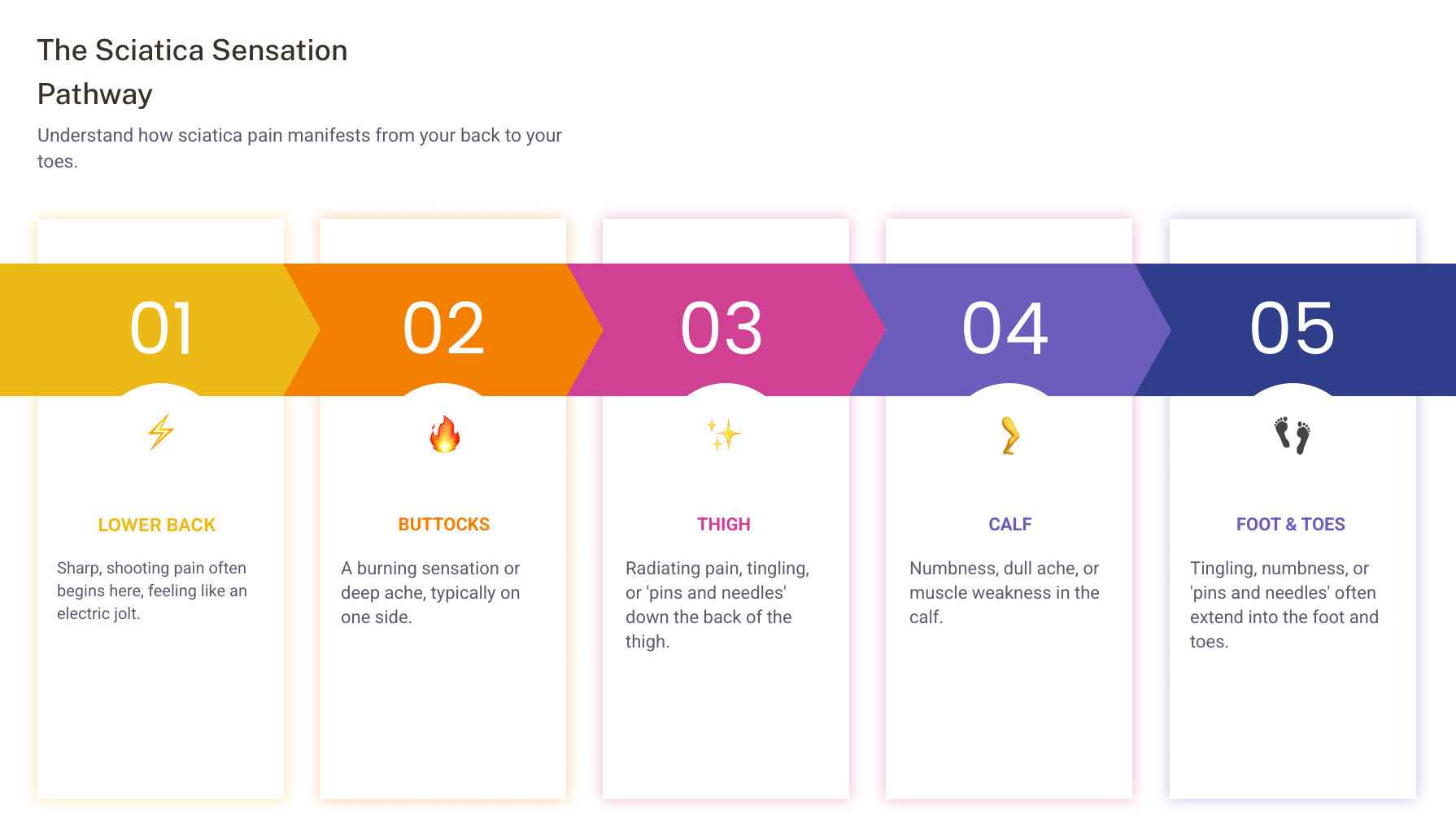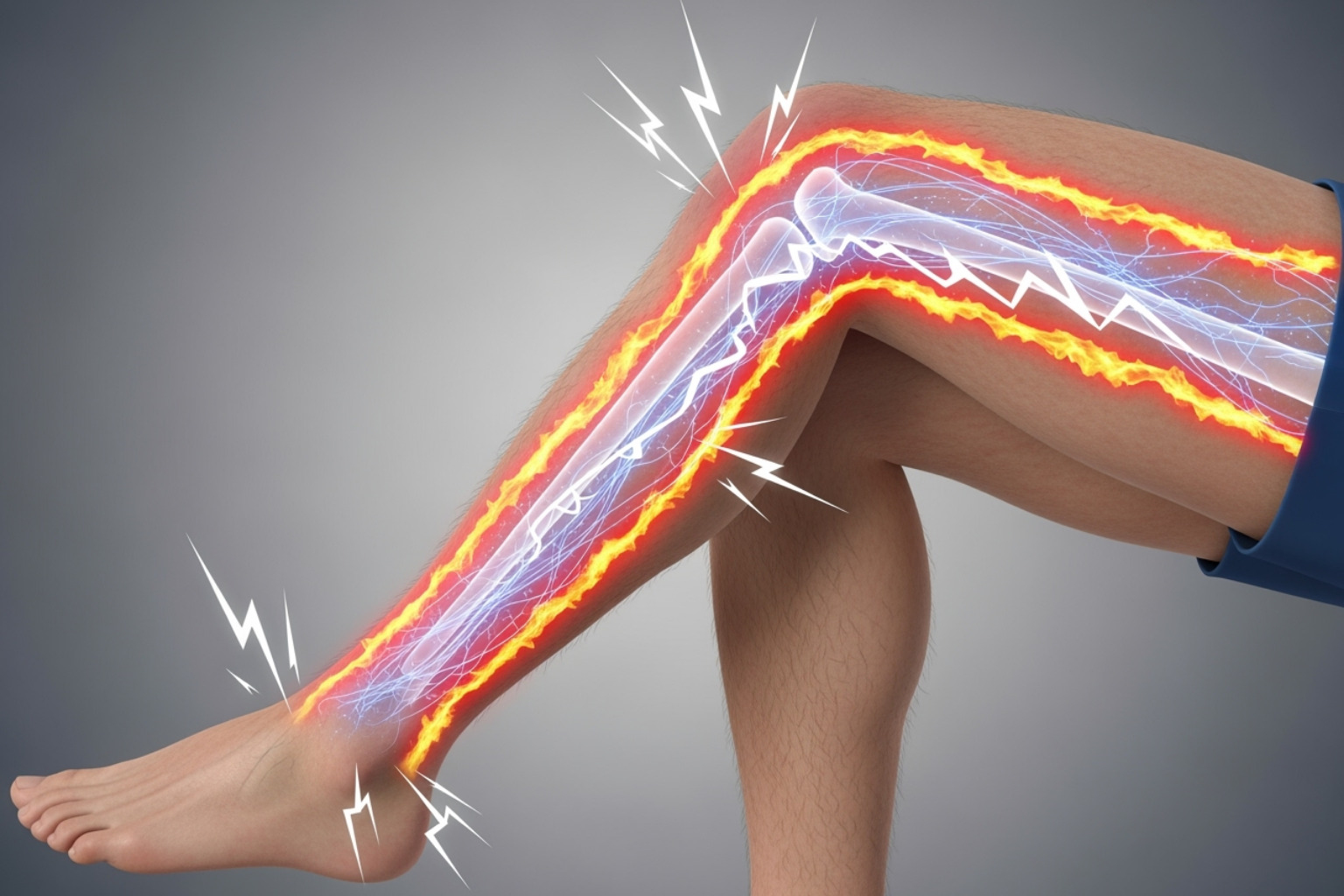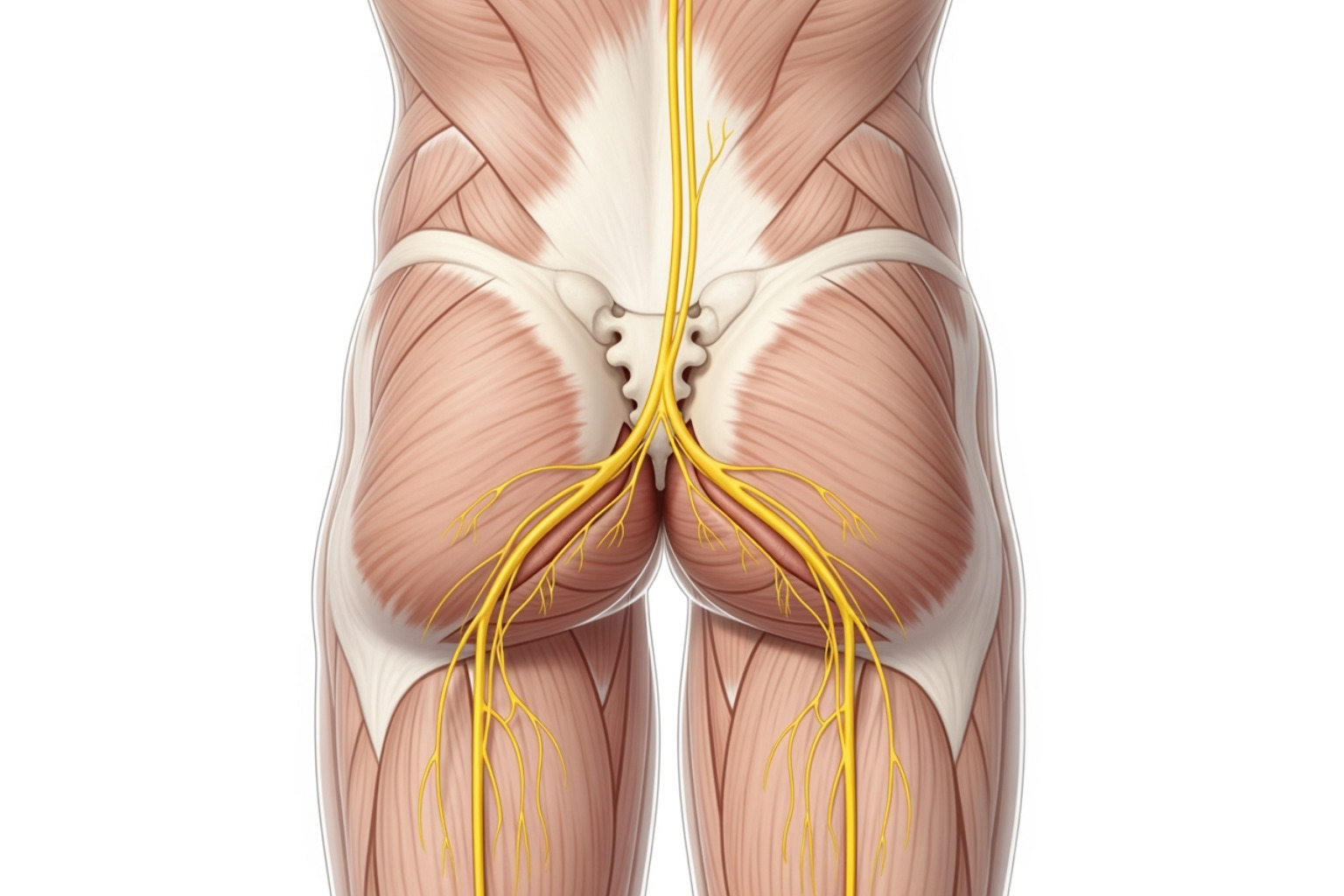Understanding the Sharp, Shooting Pain of Sciatica
What does sciatica feel like? It's a pain that can range from a mild ache to a sharp, shooting sensation that feels like an electric shock. This discomfort radiates from your lower back, through the buttocks, and down the back of your leg. You might also experience a burning feeling, tingling, numbness, or muscle weakness.
Common sensations associated with sciatica include:
- Sharp, shooting pain that radiates from the lower back down one leg
- Burning sensation or electric shock-like jolts
- Tingling or "pins and needles" in the leg, foot, or toes
- Numbness in the affected areas
- Muscle weakness in the leg or foot
- Pain that worsens with prolonged sitting or standing
Sciatica affects approximately 40% of people in the United States at some point. It's not a condition itself but a symptom of an underlying issue—typically compression or irritation of the sciatic nerve, the longest nerve in your body.
Fortunately, most people (80% to 90%) recover from sciatica without surgery. Recognizing your symptoms is the first step toward finding relief. This guide will explore sciatica sensations, causes, and when to seek medical attention, as well as treatment options like topical solutions for fast-acting nerve pain relief.
I'm Tony Enrico with Neuropasil. I've helped thousands understand what does sciatica feel like and find effective relief. Our nerve pain relief cream is formulated to address the burning, tingling, and radiating discomfort that sciatica causes.

The Spectrum of Sciatica: What Does Sciatica Feel Like?
If you've ever wondered what does sciatica feel like, it can range from a nagging, dull ache in your lower back to a sudden, sharp jolt that shoots down your leg. The pain is rarely the same from one person to the next.
Some days, you might notice a burning sensation traveling from your buttocks down your thigh. Other times, it might feel like an electric shock—a sudden, intense jolt. The pain can be mild to severe, and its intensity can shift without warning, making it difficult to stand, sit, or lie down comfortably. Understanding this spectrum helps you recognize what's happening and take action.

From a Dull Ache to an Electric Shock: Describing the Pain
Sciatica often starts quietly with a mild tingling or a dull, throbbing ache in the lower back or buttocks. This can last for hours or days. Then, a cough, sneeze, or simple bend can trigger a sharp, shooting pain that rips down your leg. This jolt or electric shock sensation is a clear sign your sciatic nerve is compressed or irritated.
The severe pain some people experience can be debilitating, making movement nearly impossible. The pain is deeply personal, ranging from a persistent dull ache to intense, sharp episodes. Communicating this range to your healthcare provider is key to finding the right treatment. For a deeper dive, see our guide: From Mild to Intense: A Comprehensive Guide to Sciatica Pain.
What does sciatica feel like beyond just pain?
What does sciatica feel like isn't just about pain. It also involves a collection of neuropathic sensations.
Numbness is common, making part of your leg or foot feel like it has "gone to sleep." You might not sense touch or temperature normally in the affected area.
Then there's tingling or "pins and needles" (paresthesia). Unlike the temporary feeling from sitting awkwardly, with sciatica, this prickly, buzzing sensation can be constant or intermittent, signaling that your sciatic nerve is under stress.
These sensations follow the nerve's path, so you might feel numbness in your buttocks and tingling down your thigh to your toes. The mix of symptoms can be confusing, with sharp pain in one area and numbness in another. These are all important signs that your sciatic nerve is irritated.
At Neuropasil, we understand how frustrating these sensations are. Our nerve pain relief cream is formulated to address not just the pain, but also the burning, tingling, and radiating discomfort of sciatica, providing fast-acting relief where you need it.
The Journey of Sciatic Pain: From Your Back Down to Your Toes
One of sciatica's most distinctive features is how the pain travels. It's not confined to one spot but follows the sciatic nerve's path. The discomfort typically begins in your lower back or buttocks and voyages down the leg, through the back of the thigh, calf, and sometimes to the foot and toes.
A key identifier is that sciatica almost always affects just one side of your body (unilateral sciatica). While pain in both legs (bilateral sciatica) can occur, it's rare and often points to a more serious issue requiring medical attention.

Tracing the Path: How Sciatica Radiates
The sciatic nerve is the longest and thickest in the body. It forms when several nerve roots (L4, L5, S1, S2, and S3) from your lower spine merge. The nerve then runs deep through your buttock, down the back of your thigh, and branches out to your lower leg and foot.
When something like a herniated disk or bone spur compresses one of these nerve roots, the pain radiates along the entire nerve pathway. This is why a problem in your lower back can cause symptoms all the way down to your toes, often described as "shooting" pain. For more on these patterns, see our article on Sciatica Pain Symptoms.
What does sciatica feel like in the Leg and Foot?
When sciatica reaches your leg and foot, it can cause more than just pain. Many people experience muscle weakness that affects daily activities. You might have trouble lifting the front of your foot (foot drop), causing it to drag when you walk. Flexing your foot or standing on your toes can become difficult.
This weakness occurs because the nerve struggles to send proper signals to your muscles, which can affect your balance. Beyond motor issues, sciatica can create unusual sensory changes. The skin on your leg might feel unusually warm or cold, or you might notice changes in sweating patterns. These symptoms, especially significant muscle weakness or difficulty walking, are important warning signs that you should not ignore.
Common Causes and Triggers of Sciatica Flare-Ups
To understand what does sciatica feel like, it helps to know what's causing it. Sciatica is a symptom that something is irritating or compressing the sciatic nerve.
The most common cause, accounting for about 90% of cases, is a herniated disk. This occurs when a spinal disk's soft center pushes through its outer layer and presses on a nerve root. Other common culprits include:
- Spinal stenosis: A narrowing of the spinal canal, often due to aging.
- Bone spurs: Bony growths on the vertebrae that can crowd nerve roots.
- Piriformis syndrome: Spasms in the piriformis muscle in the buttock can squeeze the nearby sciatic nerve.
- Degenerative disk disease: The natural aging and breakdown of spinal disks.
For more detail, see The Definitive Guide to What Causes Sciatic Nerve Pain.
The Root of the Problem: What Causes the Sciatic Nerve to Hurt?
At its core, sciatica is caused by nerve compression and inflammation. When the sciatic nerve is squeezed, it sends distress signals your brain interprets as pain, numbness, or tingling.
Certain risk factors increase your vulnerability:
- Age: Herniated disks are most common in people in their 30s and 40s, while degenerative changes increase later in life.
- Obesity: Extra weight adds stress to your spine.
- Occupation: Jobs involving heavy lifting, twisting, or prolonged sitting increase risk.
- Sedentary lifestyle: Weak core muscles offer less spinal support.
- Diabetes: This condition can increase the risk of nerve damage.
- Pregnancy: Hormonal changes and a shifting center of gravity can put pressure on the nerve.
Maintaining good posture is also crucial for preventing nerve irritation.
Everyday Actions That Can Worsen Sciatica
Ordinary activities can suddenly become painful triggers. Knowing what to avoid can help you manage flare-ups.
- Prolonged sitting or standing increases pressure on the sciatic nerve.
- Coughing or sneezing can cause a sudden spike in pressure, triggering a jolt of pain.
- Bending backward can narrow the spinal canal.
- Lifting heavy objects improperly—by bending at the waist or twisting—is a notorious trigger. Always lift with your legs.
- Straining during other activities can also increase pressure and worsen symptoms.
Is It Sciatica? Differentiating and Knowing When to Seek Help
When dealing with back and leg pain, it's important to know if it's truly sciatica. Localized back pain, for instance, stays in the back and doesn't travel down the leg. Hip arthritis pain is often felt in the groin and worsens with weight-bearing, unlike the radiating nerve pain of sciatica. Sciatica is the most common type of radiculopathy (symptoms from a pinched spinal nerve).
This table compares common conditions:
| Feature | Sciatica | General Back Pain | Hip Pain |
|---|---|---|---|
| Pain Location | Lower back/buttocks radiating down one leg (thigh, calf, foot) | Primarily in the lower back, may spread slightly | Groin, outer hip, buttock, or sometimes referred to the knee (often worse with weight-bearing/movement) |
| Pain Sensation | Sharp, shooting, burning, electric shock, tingling, numbness | Dull ache, stiffness, muscle spasms | Deep ache, stiffness, sharp pain with movement, grinding sensation |
| Radiation | Distinct pathway down the leg, often past the knee | Usually localized, or generalized ache in the back | Can radiate to groin or knee, but rarely down the entire leg in a nerve-like pattern |
| Associated Symptoms | Muscle weakness, "pins and needles," foot drop | Muscle tightness, limited flexibility | Catching, clicking, limited range of motion, limping |
| Triggers | Prolonged sitting, coughing, sneezing, lifting, twisting | Poor posture, overuse, heavy lifting, sudden movements | Walking, standing, rotating the hip, prolonged activity |
For more clinical insights, see this article on the Diagnosis and treatment of sciatica.
When to See a Doctor for Sciatica
While most mild sciatica improves with self-care, you should see a doctor if:
- Your pain lasts for more than a week without improvement.
- The pain is severe, getting progressively worse, or significantly interfering with your daily life.
- Home remedies have failed to provide relief.
Early intervention can prevent acute sciatica from becoming chronic. For management strategies, see our guide on Sciatica Relief.
Red Flags: When Sciatica Becomes an Emergency
Certain "red flag" symptoms indicate a potential emergency and require immediate medical attention. Go to an ER if you experience:
- Sudden, severe numbness or significant muscle weakness in one or both legs.
- Loss of bowel or bladder control. This can signal Cauda Equina Syndrome, a rare but serious condition requiring urgent treatment to prevent permanent paralysis.
- Pain that develops after a violent injury, such as a car accident or serious fall.
- Excruciating pain that prevents you from performing normal activities for more than a few hours.
These symptoms are not typical of sciatica and require urgent evaluation.
Frequently Asked Questions about Sciatica Pain
Living with sciatica brings up many questions about what does sciatica feel like and how long it will last. Here are answers to common concerns.
How long does it take for sciatica to go away?
It depends. For most people, acute sciatica symptoms improve within 4 to 6 weeks with conservative treatment. One study cited by the National Center for Biotechnology Information (NCBI) found that 75% of patients improved significantly within a month using non-surgical methods.
However, if symptoms persist for more than 3 months, it's considered chronic sciatica. The vast majority of people—80% to 90%—recover without surgery. The timeline depends on the underlying cause and severity.
Can sciatica affect both legs at the same time?
Bilateral sciatica (affecting both legs) is rare. Pain on just one side is a telltale sign of sciatica. When it does occur in both legs, it's a red flag for a more significant issue, such as a large central disc herniation or severe spinal stenosis. If you have symptoms down both legs, seek prompt medical attention.
Does walking make sciatica worse?
While the first instinct may be to rest, extended bed rest is counterproductive and can prolong recovery. Gentle movement is your friend.
Light activities like short walks, gentle stretching, and low-impact exercises (swimming, water aerobics) help maintain flexibility, strengthen supporting muscles, and improve blood flow. The key is to listen to your body. If a movement causes sharp pain, back off or modify it. The goal is to stay active within your comfort zone, not to push through severe pain. Finding the right balance of activity and rest, often with a physical therapist's guidance, can promote a faster recovery.
Conclusion
Understanding what does sciatica feel like—from a mild ache to a sharp, radiating pain with numbness or tingling—is the first step toward relief. We've covered its causes, triggers, and how it differs from other types of pain. We also highlighted the "red flag" symptoms that require immediate medical attention.
While many cases improve with time, managing the discomfort is key. For those seeking targeted relief, our Neuropasil nerve pain relief cream, with its blend of Aloe, Urea, and Menthol, is designed to provide soothing, fast-acting comfort for the sensations of sciatica.
Don't let nerve pain control your life. Take charge by understanding your symptoms and exploring effective relief. To learn more, visit our guide: Say Goodbye to Sciatica: The Best Creams to Soothe Your Nerves.
References
This article draws on information from trusted medical sources and peer-reviewed research to help you understand what does sciatica feel like. The guidance on symptoms, causes, and treatment is based on information from leading health institutions.
- Symptoms and Causes: Mayo Clinic and Cleveland Clinic.
- Condition Overview: National Center for Biotechnology Information (NCBI).
- Diagnosis and Treatment Statistics: NCBI.
- Posture and Pregnancy Guidance: Cleveland Clinic and its pregnancy-specific guide.
We believe in transparency and encourage you to explore these sources. Always consult your healthcare provider for personalized medical advice.














